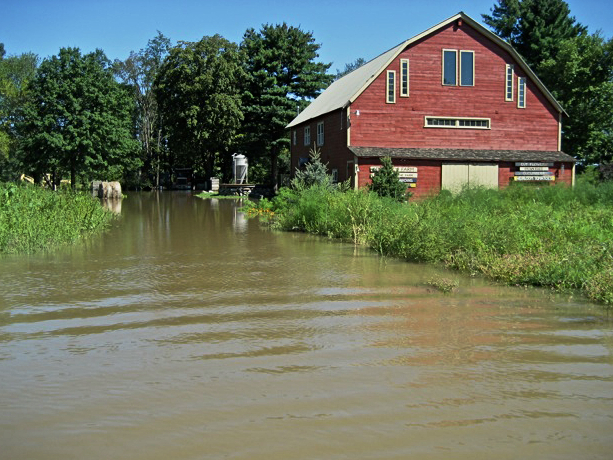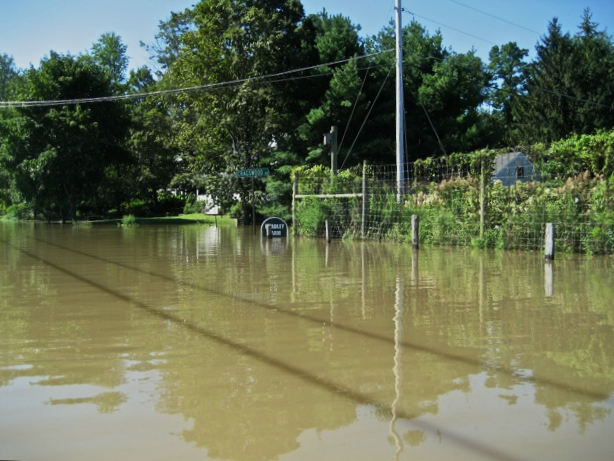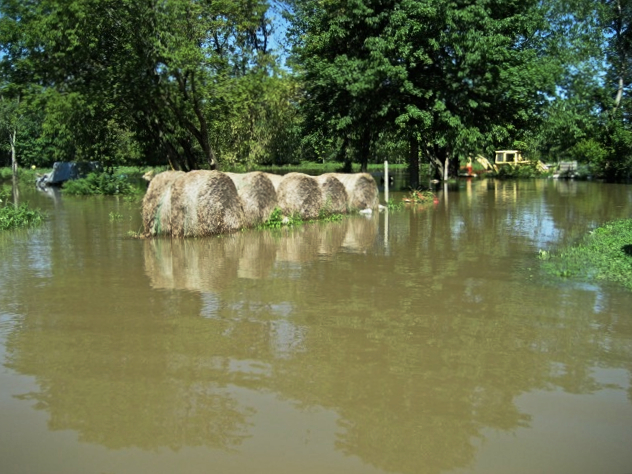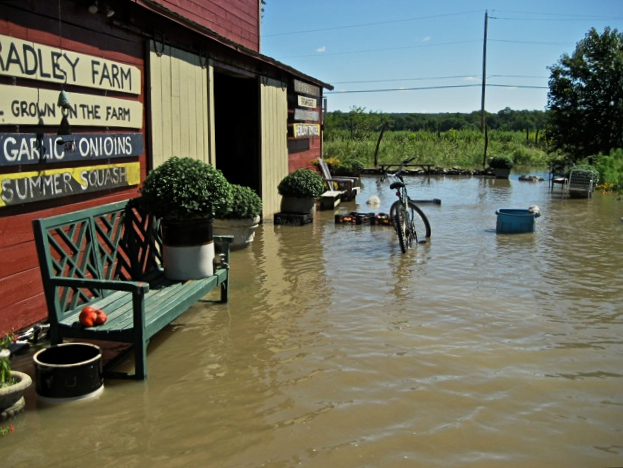Topsoil Loss and Remineralization
Topsoil is the result of a long, gradual process in which parent materials (rocks) weather and mix with decaying vegetation. The most lasting and thorough restoration of topsoil lies in imitating and accelerating the natural processes that originally created it.
Last year has seen many tragic reminders of nature’s fury. From crippling droughts in the South to widespread flooding on the East Coast, there seems to be no end to the death and destruction. Amidst the more newsworthy effects of such catastrophes is a subtle yet serious situation: the destruction or degradation of topsoil. In this regard, the Northeast has suffered more damage than most of the other afflicted areas.
Extensive, devastating floods swept through the region following heavy rainfall produced by Tropical Storm Irene and Tropical Storm Lee. As the flood waters receded, it became clear that they took something with them—topsoil, and lots of it. In some cases, the flood waters not only washed away topsoil but also deposited thick layers of sand, silt, and gravel. Simply stated, the result is agricultural ruin.
Farmers in the affected areas face dire consequences. Fertilizer expenses will increase dramatically; but even when fertilized, plants cannot grow well without adequate topsoil. Weakened, malnourished plants will be more susceptible to diseases and pests, and the nutritional value of the produce will decline. This situation must be remedied—the topsoil must be restored.
What is Topsoil?
Topsoil is the generic term used to identify the upper layer of soil that contains most of the available plant nutrients and in which most of the biological activity takes place. The soil’s organic matter is concentrated in the topsoil, making it noticeably darker than the subsoil. The topsoil is the primary home of the vast “soil food web”—the amazingly complex community of microorganisms, earthworms, insects, and small vertebrates that is the only proper home for the roots of crop plants. We must remember that the survival of the human race is inextricably bound to the maintenance of topsoil—as it declines, so does our food supply. Plants cannot grow well in lifeless subsoil, even when soluble fertilizers are supplied.
The Origin of Topsoil
When seeking the most effective ways to restore topsoil, we must first consider its origin. The most lasting and thorough restoration of topsoil lies in imitating and accelerating the natural processes that originally created it.
Topsoil is the result of a long, gradual process in which parent materials (rocks) weather and mix with decaying vegetation. Through weathering, rocks are broken down by chemical and biological processes such that their minerals become more available to various life forms. The decaying vegetation serves as an energy source for microscopic life in the soil, and the parent material contains an abundant supply of broad-spectrum minerals needed by both plants and microorganisms. So long as sufficient minerals are present in the weathering rock materials, the topsoil gradually becomes deeper and more fertile as the cycle of plant growth, organic matter decomposition, and soil life perpetuates.
Restoring Topsoil
We must remember that in its most basic form, topsoil requires two components: mineral-rich rock material and decaying vegetation. Various soil animals and microorganisms are also essential to the formation of topsoil, but in most cases these creatures will multiply rapidly in the soil if conditions are made appropriate for them.
The limiting factor in topsoil formation is the weathering of the parent material. Weathering of rock is measured in “geologic time”—in other words, it is an extremely slow process. The other aspects of topsoil formation can take place much more quickly.
The key to topsoil restoration is finely ground rock. This material goes by many names—rock dust, rock flour, stonemeal, and gravel screenings, to name a few. The geologic process of weathering can be greatly accelerated by reducing rocks to finely ground particles. “Finely ground” generally refers to rock particles that will pass through a screen with 200 mesh squares per linear inch. Quarries already produce enormous quantities of rock dust as a waste product, though the particle size may not be quite this small. If necessary, simple grinding equipment can be used to further decrease the particle size.
Most types of rock will prove effective for topsoil restoration, but some are better than others. Limestone and dolomite, though relatively easy to obtain, do not contain an adequate variety of minerals. Basalt and granite are excellent and are readily available in many areas. A mixture of rock types is usually ideal for topsoil restoration, as this will ensure the widest variety of minerals and will minimize the possibility of particular excesses or deficiencies. For more information on obtaining and utilizing high quality rock dust, refer to the Remineralize the Earth website (www.remineralize.org).
Locating and obtaining rock dust can sometimes be challenging and time consuming.
Standard agricultural practices combined with rock dust can achieve a substantial degree of topsoil restoration in a reasonable amount of time. The rock dust should be incorporated into the soil such that the rock particles are distributed throughout the top few inches of soil.
This application of rock dust should be followed by a cover crop, preferably a high-biomass mixture of cereal grains and legumes. The fibrous root systems of cereal grains, particularly rye, are in many ways ideal for rapidly filling the soil with organic matter. Legumes, if properly inoculated and incorporated at the right time, will provide some soil nitrogen to encourage the rapid growth of microorganisms. The entire cover crop should be plowed into the soil. This heavy addition of organic matter will allow the soil life to flourish, and this in turn will accelerate the biological processes that make the minerals in the rock dust readily available to succeeding crops.
The degree of topsoil restoration is limited according to the amount of rock dust that is used. It must be borne in mind that the rock dust, not the organic matter, is the fundamental component of the new topsoil. This rock dust can restore only a miniscule fraction of the original topsoil, which was formed over many years by geological processes. Consequently, rock dust should be reapplied to meet the ongoing nutritional needs of the plants and the microorganisms.
Preserving our Topsoil
The devastating floods in the Northeast serve to remind us that natural disasters can introduce profound disorder into the soil ecosystem; nonetheless, irresponsible agricultural practices constitute the primary threat to topsoil. It must be emphasized that soil aggregation is the best defense against erosion of all kinds.
Many aspects of conventional agriculture impede or prevent soil aggregation, leaving soil particles susceptible to the erosive forces of wind and water. The use of rock dust, whether to restore or maintain the topsoil, is essential in encouraging the various soil-dwelling creatures that are responsible for aggregation.
The struggle involved in restoring washed out agricultural fields should emphasize the importance of preserving our topsoil. The human race must soon realize that our most important natural resource is topsoil—starvation will be our only future if we allow it to be degraded beyond repair.
Images of farmland flooded after Hurricane Irene are courtesy of Bradley Farm.




Support us on Patreon
Thank you for joining us today! Please become a member of RTE and support us on Patreon. Unlike many larger organizations, we work with a team of determined and passionate volunteers to get our message out. We aim to continue to increase the awareness of remineralization to initiate projects across the globe that remineralize soils, grow nutrient dense food, regenerate our forests’ and stabilize the climate – with your help! If you can, please support us on a monthly basis from just $2, rest assured that you are making a big impact every single month in support of our mission. Thank you!







John
March 15, 2017 (11:40 am)
Really important concepts that need to be more broadly understood and applied.
Sariah Meagle
January 23, 2019 (1:37 am)
When you mentioned that topsoil is the upper layer of soil that contains most of the available plant nutrients, I realized that this was what I in my garden to survive so I might get topsoil from a good store. I do agree that it needs a long, gradual process as you pointed out in order to form which makes it worth growing plants with. Since you said that it composes of mineral-rich rock material and decaying vegetation, I’ll make sure that I’m going to buy just that kind of material in topsoil.